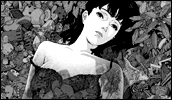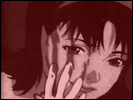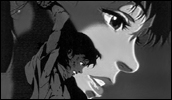Perfect Blue
- Year
- 1998
- Original title
- Pafekuto Buru
- Japanese title
- パーフェクト・ブルー
- Director
- Cast
- Running time
- 82 minutes
- Published
- 20 March 2001



by Jasper Sharp
I remember being bowled over when I caught this film for the first time on its limited release at the Institute of Contemporary Arts in London. It's a fascinating piece of work - the world's first psycho-horror rendered as a cartoon. Never mind the obvious question of why anime instead of live action. The simple fact is that to my mind it works, and it works bloody effectively.
Mima Kirigoe announces her ambition to leave the squeaky-clean manufactured J-pop girl group Cham to embark on an acting career, much to the chagrin of her fans. Her initial role of a one-line part in a psychological TV-drama called 'Double Bind' is unpromising until she is coerced by her avaricious manager to move further away from her original squeaky clean image by agreeing to a salacious rape scene. As Cham move onto greater things without her, Mima is soon partaking in steamy nude photo sessions.
Meanwhile someone is charting her inner thoughts in diary form on the 'Mima's Room' Internet fan site with an uncannily unerring accuracy. Haunted by the skulking presence of former fan Mi-Maniac, with no one but her duplicitous chaperone Rumi to turn to as her image becomes more and more manipulated by those guiding her career, she is tormented by a delusionary manifestation of her former pop persona. The divisions between her personal, public, and imaginary identity become increasingly confused as events in 'Double Bind' begin to echo that of her life and various characters involved in the production begin to die violently.
In his first film, Satoshi Kon (who previously scripted the similarly themed Magnetic Rose segment of Katsuhiro Otomo's animated portmanteau Memories in 1995) has taken the novel written by Yoshikazu Takeuchi and warped it into a darkly expressionistic thriller, whose gory murder scenes and surprising sexual content are more akin to Dario Argento than Walt Disney. Like the Italian director's exquisitely crafted giallo Tenebre (1982), Perfect Blue's script is more concerned with a violently beautiful and surprisingly cinematic aesthetic than with any degree of narrative verisimilitude. Though superficially confusing as the delineation between what is going on in Mima's head and her day-to-day reality becomes deliberately more obscured whilst the film gains momentum, there remains a rigid internal logic that steadfastly holds its own against repeated viewings.
Whether Perfect Blue manages to transcend its animated origins to spawn similar projects or merely remains as a one-off experimental novelty remains to be seen. A live action adaptation of Takeuchi's novel by pinku eiga director Toshiki Sato didn't add up to more than a half-hearted attempt. What is clear is that Satoshi Kon and his crew have created something at once refreshingly original and disturbingly beautiful and it will be interesting to see if future work can build upon this effective debut.